View in other NatureServe Network Field Guides
NatureServe
Montana
Utah
Wyoming
Idaho
Wisconsin
British Columbia
South Carolina
Yukon
California
New York
Hoary Marmot - Marmota caligata
State Rank Reason (see State Rank above)
Species is common to uncommon in alpine meadows and associated subalpine habitat across western Montana. Some populations are relatively isolated. Threats include changing climate and impacts on juvenile, but the impacts of this are poorly understood in this species.
General Description
The hoary marmot is a large, stocky rodent about 70 cm in total length and 5 kg in weight. Its head is broad and round with small, well-furred ears, and its neck is short. Its feet have strong claws, as well as nearly circular pads on the hind feet which distinguish it from other marmots. Its long tail makes up nearly a third of its total length. Fur is coarse, with many white-tipped guard hairs rendering a grizzled appearance; hence, the name “hoary”. The head and front third of the body are usually black, as are the feet, and the belly is lighter in color. (Foresman 2012)
Diagnostic Characteristics
Can be distinguished fairly readily from Montana’s other marmot, the yellow-bellied marmot, based on color; the hoary marmot is whitish gray and grizzled, whereas the yellow-bellied marmot is, as its name suggests, yellowish brown to tawny with a distinctly yellow belly. The hoary marmot is the larger of the two species. Where their ranges overlap, hoary marmots are found in alpine habitats and yellow-bellied marmots at lower elevations. (Foresman 2012)
Species Range
Montana Range
Range Descriptions
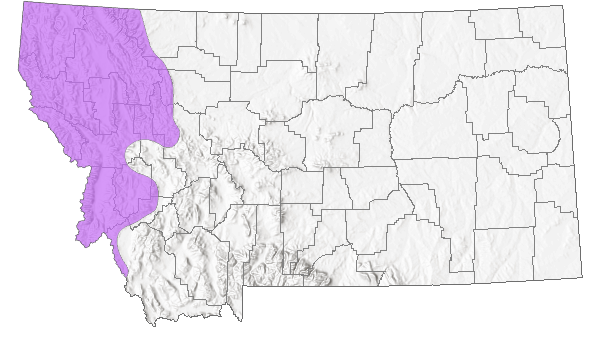
 Native
Native
Western Hemisphere Range

Observations in Montana Natural Heritage Program Database
Number of Observations: 1239
(Click on the following maps and charts to see full sized version)
Map Help and Descriptions
Relative Density
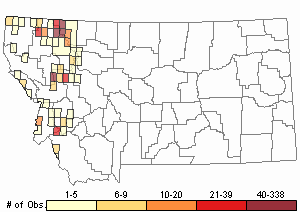
Recency
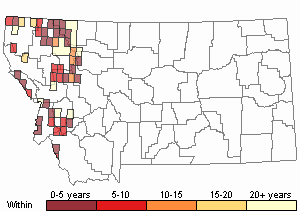
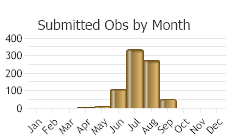
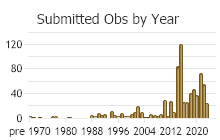
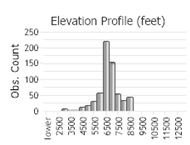 (Observations spanning multiple months or years are excluded from time charts)
(Observations spanning multiple months or years are excluded from time charts)
Migration
Non-migratory.
Habitat
Occupies alpine and subalpine habitats, with burrows in rock outcrops, boulder fields, or talus slopes adjacent to meadows.
National Vegetation Classification System Groups Associated with this Species
Alpine
Alpine - Sparse and Barren
Alpine - Vegetated
Forest and Woodland
Montane - Subalpine Forest and Woodland
Shrubland
Foothills - Montane Shrubland
Grassland
Montane - Subalpine Grassland
Wetland and Riparian
Alpine Riparian and Wetland
Wet Meadow and Marsh
Food Habits
A diurnal herbivore that is fairly selective in the plants that it eats. In Montana, hoary marmots eat many flowering species, including silky lupine, Indian paintbrush, and glacier lily, as well as grasses and sedges (Foresman 2012).
Ecology
Highly social (Braun et al. 2011). Colonies are typically made up of one adult male, one or more adult females, yearlings, and young-of-the-year (Foresman 2012). At two years of age, offspring disperse from the natal colony. Colonies maintain separate burrows for hibernation, sleeping, and refuge from predators (Braun et al. 2011).
Spends the majority of its life hibernating. In Montana, hoary marmots hibernated from September to early May (Foresman 2012).
May be able to outcompete Marmota flaviventris in high-elevation habitats (Hoffman 1974).
Reproductive Characteristics
Immediately after marmots emerge from hibernation, reproductive activity begins. Gestation is about 30 days, with an average litter size of 2-4. Females tend to reproduce every other year. Both males and females are sexually mature at 3 years of age. (Foresman 2012)
Management
Marmot populations are vulnerable to climate change for several reasons: their physiology is adapted to low temperatures, and they are stressed by high heat loads; warming temperatures are associated with drier, unpalatable vegetation; and drought reduces reproduction and increases mortality, meaning that reductions in summer rainfall could lead to local extinctions. Species like the hoary marmot that live in high alpine areas are most vulnerable, as they have little opportunity to move farther upslope with warming conditions. (Armitage 2013)
Stewardship Responsibility
References
- Literature Cited AboveLegend:
 View Online Publication
View Online Publication Foresman, K.R. 2012. Mammals of Montana. Second edition. Mountain Press Publishing, Missoula, Montana. 429 pp.
Foresman, K.R. 2012. Mammals of Montana. Second edition. Mountain Press Publishing, Missoula, Montana. 429 pp.
- Additional ReferencesLegend:
 View Online Publication
View Online Publication
Do you know of a citation we're missing? Adelman, E.B. 1979. A survey of the nongame mammals in the Upper Rattlesnake Creek drainage of western Montana. M.S. thesis. University of Montana, Missoula. 129 pp.
Adelman, E.B. 1979. A survey of the nongame mammals in the Upper Rattlesnake Creek drainage of western Montana. M.S. thesis. University of Montana, Missoula. 129 pp. Barash, D.P. 1973. Habitat utilization in three species of subalpine mammals. Journal of Mammalogy. 54(1): 247-250.
Barash, D.P. 1973. Habitat utilization in three species of subalpine mammals. Journal of Mammalogy. 54(1): 247-250. Barash, D.P. 1974. The social behavior of the hoary marmot (Marmota caligata). Animal Behaviour. 22(1): 256-261.
Barash, D.P. 1974. The social behavior of the hoary marmot (Marmota caligata). Animal Behaviour. 22(1): 256-261. Dice, L.R. 1923. Mammal associations and habitats of the Flathead Lake Region, Montana. Ecology 4(3): 247-260.
Dice, L.R. 1923. Mammal associations and habitats of the Flathead Lake Region, Montana. Ecology 4(3): 247-260. Fikkan, P., J. Fikkan, J. Collier, and R. Kresek. 1973. Some observations of a Fisher at close range. The Murrelet 54(2):22
Fikkan, P., J. Fikkan, J. Collier, and R. Kresek. 1973. Some observations of a Fisher at close range. The Murrelet 54(2):22 Flath, D.L. 1979. Nongame species of special interest or concern: Mammals, birds, reptiles, amphibians, fishes. Wildlife Division, Montana Department of Fish and Game. Helena, MT.
Flath, D.L. 1979. Nongame species of special interest or concern: Mammals, birds, reptiles, amphibians, fishes. Wildlife Division, Montana Department of Fish and Game. Helena, MT. Foresman, K.R. 2001. The wild mammals of Montana. American Society of Mammalogists, Special Publication Number 12. Lawrence, KS. 278 pp.
Foresman, K.R. 2001. The wild mammals of Montana. American Society of Mammalogists, Special Publication Number 12. Lawrence, KS. 278 pp. Hoffmann, R.S. and D.L. Pattie. 1968. A guide to Montana mammals: identification, habitat, distribution, and abundance. Missoula, MT: University of Montana. 133 p.
Hoffmann, R.S. and D.L. Pattie. 1968. A guide to Montana mammals: identification, habitat, distribution, and abundance. Missoula, MT: University of Montana. 133 p. Hoffmann, R.S., P.L. Wright, and F.E. Newby. 1969. The distribution of some mammals in Montana. I. Mammals other than bats. Journal of Mammalogy 50(3): 579-604.
Hoffmann, R.S., P.L. Wright, and F.E. Newby. 1969. The distribution of some mammals in Montana. I. Mammals other than bats. Journal of Mammalogy 50(3): 579-604. Joslin, Gayle, and Heidi B. Youmans. 1999. Effects of recreation on Rocky Mountain wildlife: a review for Montana. [Montana]: Montana Chapter of the Wildlife Society.
Joslin, Gayle, and Heidi B. Youmans. 1999. Effects of recreation on Rocky Mountain wildlife: a review for Montana. [Montana]: Montana Chapter of the Wildlife Society. Reichel, J.D. 1986. Habitat use by alpine mammals in the Pacific Northwest. Arctic and Alpine Research. 18(1): 111-119.
Reichel, J.D. 1986. Habitat use by alpine mammals in the Pacific Northwest. Arctic and Alpine Research. 18(1): 111-119. Reid, F. 2006. Peterson Field Guide to Mammals of North America, 4th Edition. Houghton Mifflin Company: Boston and New York, 608 pp.
Reid, F. 2006. Peterson Field Guide to Mammals of North America, 4th Edition. Houghton Mifflin Company: Boston and New York, 608 pp. Rust, H. J. 1946. Mammals of northern Idaho. J. Mammal. 27(4): 308-327.
Rust, H. J. 1946. Mammals of northern Idaho. J. Mammal. 27(4): 308-327. Thompson, Richard W., Western Resource Dev. Corp., Boulder, CO., 1996, Wildlife baseline report for the Montana [Montanore] Project, Lincoln and Sanders counties, Montana. In Application for a Hard Rock Operating Permit and Proposed Plan of Operation, Montanore Project, Lincoln and Sanders Counties, Montana. Vol. 5. Stroiazzo, John. Noranda Minerals Corp., Libby, MT. Revised September 1996.
Thompson, Richard W., Western Resource Dev. Corp., Boulder, CO., 1996, Wildlife baseline report for the Montana [Montanore] Project, Lincoln and Sanders counties, Montana. In Application for a Hard Rock Operating Permit and Proposed Plan of Operation, Montanore Project, Lincoln and Sanders Counties, Montana. Vol. 5. Stroiazzo, John. Noranda Minerals Corp., Libby, MT. Revised September 1996. Turncock, B.Y., A.R. Litt, J.M. Vore, and C.A.M. Hammond. 2017. Habitat characteristics of the hoary marmot: assessing distribution limitations in Montana. Ecosphere Article e01977 8(10):1-14.
Turncock, B.Y., A.R. Litt, J.M. Vore, and C.A.M. Hammond. 2017. Habitat characteristics of the hoary marmot: assessing distribution limitations in Montana. Ecosphere Article e01977 8(10):1-14. Turnock, B.Y. 2016. Characterizing habitat relationships and establishing monitoring strategies for an alpine obligate. MS Thesis. Montana State University. Bozeman, MT. 95pp + appendices
Turnock, B.Y. 2016. Characterizing habitat relationships and establishing monitoring strategies for an alpine obligate. MS Thesis. Montana State University. Bozeman, MT. 95pp + appendices Tyser, R.W. 1980. Use of substrate for surveillance behaviors in a community of talus slope mammals. The American Midland Naturalist 104(1): 32-38.
Tyser, R.W. 1980. Use of substrate for surveillance behaviors in a community of talus slope mammals. The American Midland Naturalist 104(1): 32-38. Tyser, Robin W. 1978. Foraging and substrate use patterns in talus slope mammals. PhD Dissertation. University of Wisconsin-Madison. 142pp.
Tyser, Robin W. 1978. Foraging and substrate use patterns in talus slope mammals. PhD Dissertation. University of Wisconsin-Madison. 142pp.
- Web Search Engines for Articles on "Hoary Marmot"
- Additional Sources of Information Related to "Mammals"





